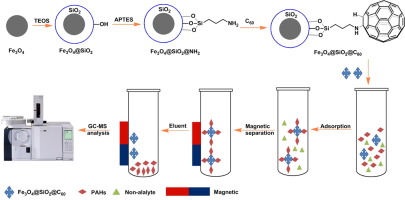当前位置:
X-MOL 学术
›
J. Chromatogr. B
›
论文详情
Our official English website, www.x-mol.net, welcomes your feedback! (Note: you will need to create a separate account there.)
Magnetic C60 nanospheres based solid-phase extraction coupled with isotope dilution gas chromatography-mass spectrometry method for the determination of sixteen polycyclic aromatic hydrocarbons in Chinese herbal medicines.
Journal of Chromatography B ( IF 3 ) Pub Date : 2020-03-20 , DOI: 10.1016/j.jchromb.2020.122076 Dian-Bing Zhou 1 , Fang Han 1 , Lei Ding 1 , Wei Song 1 , Ya-Ning Lv 1 , Yan-Yun Hu 2 , Yu-Xin Liu 1 , Xuan Sheng 1 , Ping Zheng 1
Journal of Chromatography B ( IF 3 ) Pub Date : 2020-03-20 , DOI: 10.1016/j.jchromb.2020.122076 Dian-Bing Zhou 1 , Fang Han 1 , Lei Ding 1 , Wei Song 1 , Ya-Ning Lv 1 , Yan-Yun Hu 2 , Yu-Xin Liu 1 , Xuan Sheng 1 , Ping Zheng 1
Affiliation

|
C60-based magnetic nanospheres were synthesized by coating Fe3O4 nanospheres with silica, then modifying with 3-aminopropyltriethoxysilane as a linker and a C60 fullerene stationary phase. The morphologies, magnetic properties, infrared absorption and carbon content of magnetic nanospheres were studied by TEM, VSM, FTIR and carbon and sulfur analyzer. The magnetic nanospheres were employed for the magnetic solid-phase extraction (MSPE) of 16 polycyclic aromatic hydrocarbons (PAHs) in nine Chinese herbal medicines. The analyses were conducted by isotope dilution gas chromatography-mass spectrometry. The main parameters influencing the extraction, including extraction solvent, adsorbent amount, and extraction time were optimized. Method validation showed that the limit of detection (LOD) was 0.02-0.11 µg/kg, and the limit of quantification (LOQ) was 0.07-0.36 µg/kg. The spiked recoveries rates for 16 PAHs in white peony root were 84.7-107.2%. The relative standard deviation (RSD) was 1.7-8.4%. The established method was further used for the determination 16 PAHs in nine Chinese herbal medicines. Total content of 16 PAHs varied from 73.6 µg/kg (fructus lycii) to 2172.6 µg/kg (astragalus root). The results indicate that the pollution of PAHs in Chinese herbal medicines is serious. The established method can effective detect PAHs contamination in Chinese herbal medicines.
中文翻译:

基于磁性C60纳米球的固相萃取-同位素稀释气相色谱-质谱法测定中草药中的16种多环芳烃。
通过用二氧化硅涂覆Fe3O4纳米球,然后用3-氨基丙基三乙氧基硅烷作为连接基和C60富勒烯固定相进行改性,来合成C60基磁性纳米球。用TEM,VSM,FTIR和碳硫分析仪研究了磁性纳米球的形貌,磁性,红外吸收和碳含量。磁性纳米球用于九种中草药中16种多环芳烃(PAH)的磁性固相萃取(MSPE)。通过同位素稀释气相色谱-质谱法进行分析。优化了影响萃取的主要参数,包括萃取溶剂,吸附剂用量和萃取时间。方法验证表明,检出限(LOD)为0.02-0.11 µg / kg,定量限(LOQ)为0.07-0.36 µg / kg。白中16种多环芳烃的加标回收率为84.7-107.2%。相对标准偏差(RSD)为1.7-8.4%。所建立的方法进一步用于测定九种中草药中的16种多环芳烃。16种多环芳烃的总含量从73.6 µg / kg(枸杞)到2172.6 µg / kg(芦笋根)不等。结果表明,中草药中多环芳烃的污染严重。建立的方法可以有效检测中草药中多环芳烃的污染。16种多环芳烃的总含量从73.6 µg / kg(枸杞)到2172.6 µg / kg(芦笋根)不等。结果表明,中草药中多环芳烃的污染严重。建立的方法可以有效检测中草药中多环芳烃的污染。16种多环芳烃的总含量从73.6 µg / kg(枸杞)到2172.6 µg / kg(芦笋根)不等。结果表明,中草药中多环芳烃的污染严重。建立的方法可以有效检测中草药中多环芳烃的污染。
更新日期:2020-03-20
中文翻译:

基于磁性C60纳米球的固相萃取-同位素稀释气相色谱-质谱法测定中草药中的16种多环芳烃。
通过用二氧化硅涂覆Fe3O4纳米球,然后用3-氨基丙基三乙氧基硅烷作为连接基和C60富勒烯固定相进行改性,来合成C60基磁性纳米球。用TEM,VSM,FTIR和碳硫分析仪研究了磁性纳米球的形貌,磁性,红外吸收和碳含量。磁性纳米球用于九种中草药中16种多环芳烃(PAH)的磁性固相萃取(MSPE)。通过同位素稀释气相色谱-质谱法进行分析。优化了影响萃取的主要参数,包括萃取溶剂,吸附剂用量和萃取时间。方法验证表明,检出限(LOD)为0.02-0.11 µg / kg,定量限(LOQ)为0.07-0.36 µg / kg。白中16种多环芳烃的加标回收率为84.7-107.2%。相对标准偏差(RSD)为1.7-8.4%。所建立的方法进一步用于测定九种中草药中的16种多环芳烃。16种多环芳烃的总含量从73.6 µg / kg(枸杞)到2172.6 µg / kg(芦笋根)不等。结果表明,中草药中多环芳烃的污染严重。建立的方法可以有效检测中草药中多环芳烃的污染。16种多环芳烃的总含量从73.6 µg / kg(枸杞)到2172.6 µg / kg(芦笋根)不等。结果表明,中草药中多环芳烃的污染严重。建立的方法可以有效检测中草药中多环芳烃的污染。16种多环芳烃的总含量从73.6 µg / kg(枸杞)到2172.6 µg / kg(芦笋根)不等。结果表明,中草药中多环芳烃的污染严重。建立的方法可以有效检测中草药中多环芳烃的污染。


























 京公网安备 11010802027423号
京公网安备 11010802027423号